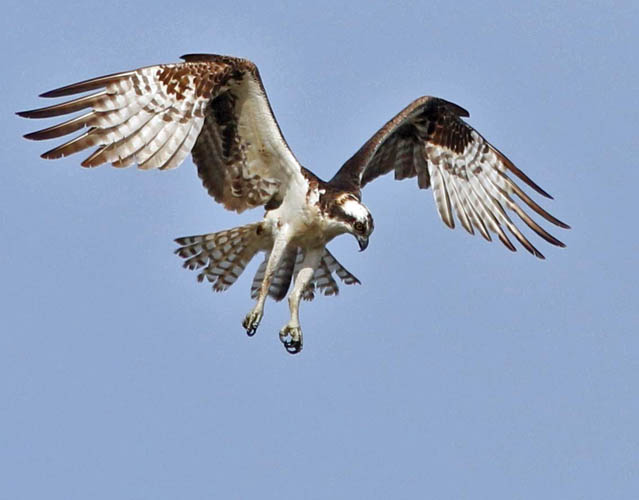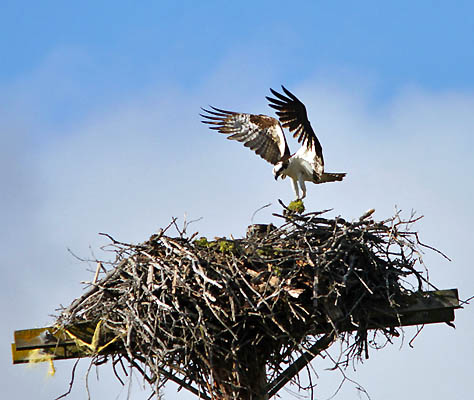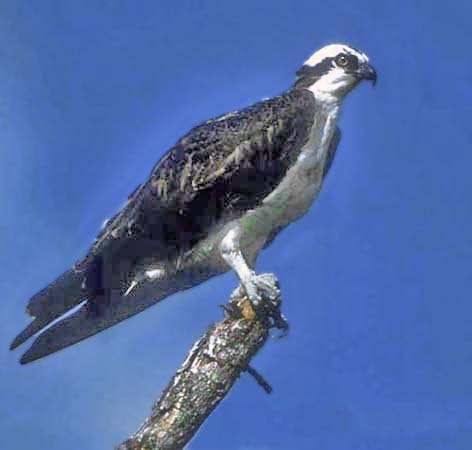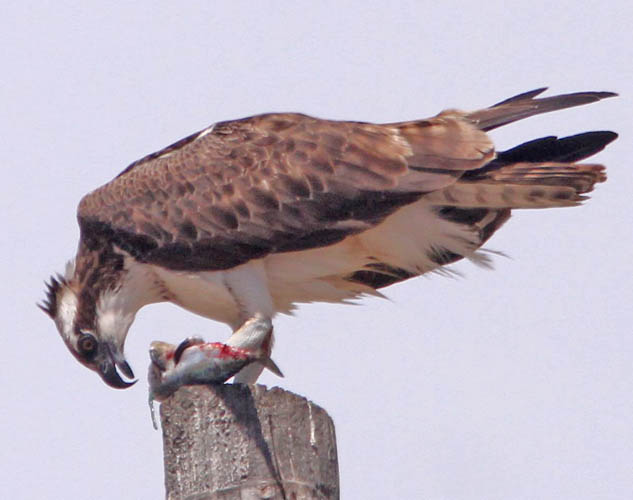
a web page by Don Roberson |
OSPREY Pandionidae |
|
|
|
 The Osprey (left) has traditionally been considered to belong to its own monotypic family,
the Pandionidae. This arrangement emphasizes several unique features of
this "fish-hawk:" numerous adaptations for a life of fishing (reversible
outer toe, spiny foot pads, nasal valves that close underwater, and more).
The Osprey's wings are long and rather narrow (left), and held sharply
angled at the carpal joints. This wing structure allows for long migrations
on strong wingbeats and short glides, rather than a reliance of thermals.
The large black carpal patches and the black line through the eye to the
hindneck are its most distinctive plumage patterns. It is always very impressive
to watch an Osprey hunting low over a lake, and then grabbing a large fish
with its feet! Sometimes it then has to battle aerial pirates — including
Bald Eagles — to bring the fish to a favored perch for consumption. The Osprey (left) has traditionally been considered to belong to its own monotypic family,
the Pandionidae. This arrangement emphasizes several unique features of
this "fish-hawk:" numerous adaptations for a life of fishing (reversible
outer toe, spiny foot pads, nasal valves that close underwater, and more).
The Osprey's wings are long and rather narrow (left), and held sharply
angled at the carpal joints. This wing structure allows for long migrations
on strong wingbeats and short glides, rather than a reliance of thermals.
The large black carpal patches and the black line through the eye to the
hindneck are its most distinctive plumage patterns. It is always very impressive
to watch an Osprey hunting low over a lake, and then grabbing a large fish
with its feet! Sometimes it then has to battle aerial pirates — including
Bald Eagles — to bring the fish to a favored perch for consumption.
|
|
 Because
it is so widespread and is conspicuous around the margins of lakes,
swamps, and on coastlines, Ospreys have been widely studied, and much
is known about their ecology, behavior, biology, and migrations.
Bretagnolle & Thibault (1993), for example, conducted a two year
study on Osprey communications on Corsica. The identified 11 visual
displays that are used to communicate in a semi-colonial environment
without feeding territories. Protecting the young in the large exposed
nests (bulky nests built atop drowned trees in many cases) is a key
element in these communications. Here (right), an adult is still
involved in nest-building, and is bringing in some moss for the center
of the nest. Because
it is so widespread and is conspicuous around the margins of lakes,
swamps, and on coastlines, Ospreys have been widely studied, and much
is known about their ecology, behavior, biology, and migrations.
Bretagnolle & Thibault (1993), for example, conducted a two year
study on Osprey communications on Corsica. The identified 11 visual
displays that are used to communicate in a semi-colonial environment
without feeding territories. Protecting the young in the large exposed
nests (bulky nests built atop drowned trees in many cases) is a key
element in these communications. Here (right), an adult is still
involved in nest-building, and is bringing in some moss for the center
of the nest. |
|
Poole (1994) lists four subspecies of Osprey: migratory populations in North America and Asia (P.h. carolinensis and nominate halietus, respectively) and two non-migratory populations (P.h. ridgwayi in the Caribbean; cristatus from Java and New Guinea through Australia). Poole (1994) points to an interesting fact: despite its long history, Osprey has not evolved into different species. The fish-eating Haliaeetus sea-eagles, in contrast, have evolved into 8 separate species over a range nearly identical to that of the Osprey. Most of these eagles are, however, non-migratory, allowing for isolation and speciation. The long-distance migration of much of the Osprey population has permitted interchange between populations and less chance for subspecies to become isolated and evolve as species over time. As it is a worldwide bird, this is surely the easiest of all monotypic families to locate! This one (right, in a fine shot by John Van de Graaff) is of the North American race carolinensis, in the Florida Everglades. |
|
|
|
Photos: The hovering Osprey Pandion haliaetus was at Moss Landing, California, on 17 Jan 2015. The nest-building adult was at Iron Gate Reservoir, Siskiyou Co., Calif., on 24 June 2012. The Everglades bird was taken by John Van de Graaff in Florida in Dec 2001. The fish-eating Osprey was at the Salinas River mouth, Monterey Co., Calif., on 29 Aug 2015.
Bibliographic note Poole (1989) is an entire book on the life history and ecology of Osprey; we might think of it as a family book. An excellent introduction to this family, incorporated much research and extensively illustrated with great photos, is in Poole (1994). Other literature cited: Bretagnolle, V., and J-C. Thibault. 1993. Communicative behavior in breeding Ospreys (Pandion haliaetus): description and relationship of signals to life history. Auk 110:736-751. |

